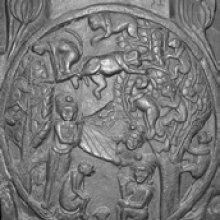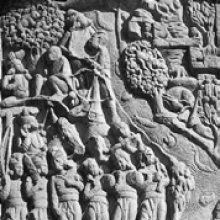Mahakapi Jataka, Mahākapi-jātaka: 1 definition
Introduction:
Mahakapi Jataka means something in Buddhism, Pali. If you want to know the exact meaning, history, etymology or English translation of this term then check out the descriptions on this page. Add your comment or reference to a book if you want to contribute to this summary article.
Images (photo gallery)
In Buddhism
Theravada (major branch of Buddhism)
Source: Pali Kanon: Pali Proper NamesMahakapi Jataka 1 1. Mahakapi Jataka (No. 407)
The Bodhisatta was once a monkey, leader of eighty thousand. In the grove where they lived was a mango tree (some say a banyan) growing on a river bank bearing fruit of divine flavour, and the monkeys were always careful to let no fruit drop into the river. But one day a fruit, which bad been hidden by an ants nest, fell into the water, and was picked up at Benares, where the king was bathing. The king tasted it, and being seized with a desire to eat more, had many rafts made, and ascended the river with a company of foresters. They found the tree, and the king, having eaten his fill, lay down at the foot. At midnight the Bodhisatta came with his retinue and started eating the mangoes. The king was disturbed, and gave orders to his archers that the wood should be surrounded and all the monkeys shot at daybreak. But the Bodhisatta was a real leader; he ascended a straight growing branch and, with one leap, reached the river bank. He then marked the distance, and having cut off a bamboo shoot of the required length, fastened one end to a tree on the bank and the other end round his waist. On leaping back, he found he had not allowed for the length which went round his waist, but grasping a branch firmly with both hands, he signalled to his followers to cross the bridge so formed. The eighty thousand monkeys thus escaped; but the monkey who was Devadatta, coming last, saw a chance of injuring the Bodhisatta, and taking a spring into the air, fell on the Bodhisattas back, breaking it, There the Bodhisatta hung in agony, and the king who had seen all this caused him to be brought down and covered with a yellow robe and ministered to. But nothing could be done, and the Bodhisatta died after having admonished the king. A funeral pyre was made with one hundred wagon loads of timber, and the dead monkey was paid all the honours due to a king. A shrine was built on the spot where the cremation took place, while the skull was inlaid with gold and taken to Benares, where a great feast was held in its honour for seven days. Afterwards it was enshrined and offerings were made to it.
The story was told concerning good works towards ones relations, as narrated in the introduction to the Bhaddasala Jataka. Ananda is identified with the king. J.iii.369-75; cf. Jatakamala, No. 27; the story is sculptured in the stupa of Bharhut, Cunningham, pl.xxxiii.4.
The Jataka is also called the Rajovada Jataka. It is probably this story which is said to have greatly impressed Ilanaga when he heard it from the Thera Mahapaduma, who lived in Tuladhara. Mhv.xxxv.30.
2. Mahakapi Jataka (No. 516)The Bodhisatta was once a monkey, and one day, in the forest, he came across a man who had fallen into a pit while looking for his oxen and had lain there starving for ten days.
Theravāda is a major branch of Buddhism having the the Pali canon (tipitaka) as their canonical literature, which includes the vinaya-pitaka (monastic rules), the sutta-pitaka (Buddhist sermons) and the abhidhamma-pitaka (philosophy and psychology).
See also (Relevant definitions)
Partial matches: Jataka, Mahakapi.
Full-text: Bhaddekaratta Sutta, Rajovada Jataka.
Relevant text
Search found 2 books and stories containing Mahakapi Jataka, Mahākapi-jātaka; (plurals include: Mahakapi Jatakas, jātakas). You can also click to the full overview containing English textual excerpts. Below are direct links for the most relevant articles:
The Jataka tales [English], Volume 1-6 (by Robert Chalmers)
The Great Chronicle of Buddhas (by Ven. Mingun Sayadaw)
Part 4 - What is the Sequence in which the Pāramī are arranged? < [Chapter 7 - On Miscellany]

